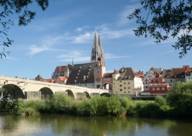
The medieval old town of Regensburg is one of the largest in Germany and a UNESCO World Heritage Site. Attractions here include the Steinerne Brücke, Regensburg Cathedral, the historic Wurstkuchl and, a little further afield, the Valhalla memorial.
- Regensburg and its medieval old town
- Sights in Regensburg: Steinerne Brücke and the Cathedral
- Danube boat trip, castle and Wurstkuchl – things to experience here
- The Valhalla memorial: Marble busts and memorial plaques
- Regensburg: How to get there from Munich
Bavaria has many beautiful cities, but Regensburg is a special jewel, as the city centre is almost completely intact despite several air raids and bombings during the Second World War. That's why today you'll find the largest medieval old town in Regensburg, which is also a UNESCO World Heritage Site. There are more than 1500 heritage-listed buildings in Bavaria's fourth-largest city, and among the most important structures dating back to the Middle Ages are the Steinerne Brücke (stone bridge), considered the oldest stone bridge in Germany, and Regensburg Cathedral – both of which are now landmarks of the city.
Construction on Regensburg Cathedral began in 1275, but the two cathedral towers only followed 600 years later. Today, along with Cologne Cathedral, Regensburg Cathedral is one of the most important Gothic cathedrals in Germany and the only one in the whole of Bavaria. The cathedral is the final resting place of great princes and bishops, and many myths and stories are woven in the historic building. However, it is best to admire it yourself: The cathedral is open daily and admission is free. The performances of the cathedral choir, the famous Regensburger Domspatzen, are extremely popular.
Just a few hundred metres away is the Steinerne Brücke (stone bridge), which was built between 1135 and 1146 and connects Regensburg's historic old town with the opposite bank of the Danube. “Stadtamhof", a small town located there, was independent until the 1920s and became an island in the city in 1970, when the Europe Canal was built. After its completion, the bridge was considered a medieval masterpiece and was even called the "eighth wonder of the world" in Regensburg. Back then, it was the only bridge over the Danube between Ulm and Vienna, which naturally boosted long-distance trade and Regensburg benefited from tolls.
In the heart of Regensburg's old town is the third most important sight: Wurstkuchl. For over 500 years, this historic snack bar right on the waterfront has been serving home-made sausages from an open charcoal grill. The sausages are served with sauerkraut from the owners own fermenting cellar and mustard made according to an original historical recipe. Germany's oldest café is also located in Regensburg's old town: Café Prinzess has been serving fine coffee since 1686, and used to supply the Counts of Thurn and Taxis. The Thurn and Taxis Palace of the same name, also known as St. Emmeram's Palace, is located not far from the railway station, at the southern end of the old town, and is the largest inhabited palace in Europe.
Regensburg lies at the northernmost point of the Danube and is also called the "city of four rivers", because the Regen, the Naab and the Schwarze Laber also flow around the city. In addition, there are the two Danube islands of Oberer and Unterer Wöhrd – so a city tour by boat is the obvious choice: The MS Bruckmadl, for example, departs several times a day and presents the medieval city to its visitors from the water. A boat trip is also ideal for exploring the surrounding countryside – such as the Danube breakthrough at Kehlheim or the Valhalla, another popular destination around Regensburg.
The Valhalla memorial is not far from the centre of Regensburg. It can be reached by car in about twenty minutes, but you can also take the public bus from Regensburg railway station. The architect Leo von Klenze, who also designed several significant buildings in Munich, such as the Ruhmeshalle (Hall of Fame) at the Bavaria (statue) and the Königsplatz (square), planned the impressive memorial. The foundation stone was laid in 1830, and the Valhalla was finally opened twelve years later. Today, more than 130 busts and 65 commemorative plaques of personalities are on display here, including resistance fighter Sophie Scholl, writer Heinrich Heine and famous painter Albrecht Dürer. New personalities are added every few years.
Originally, King Ludwig I commissioned the Valhalla to be built in the Englischer Garten (park) in Munich, but then the present location was chosen near Regensburg, towering over the Danube valley. The memorial is situated on a hill and, in good weather, offers a view over the entire valley, in places as far as the Alps. The entire complex, including the temple and its substructure with stairs, is 125 metres long and 55 metres high. The architect's inspiration from the famous Pantheon on the Acropolis in Athens is unmistakable. And that's exactly why the temple in the middle of Bavaria appears particularly exotic.
Train connection: approx. 1.5 - 2 hours. Information at bahn.de
Car: approx. 1.5 hours via the A9 and A93 motorways